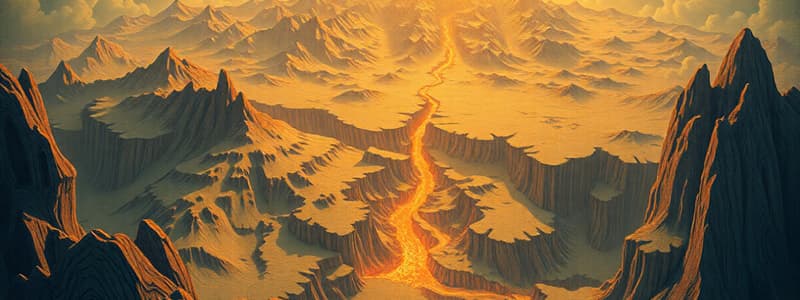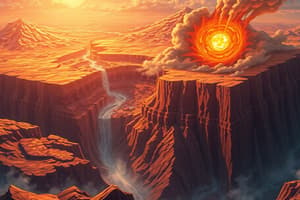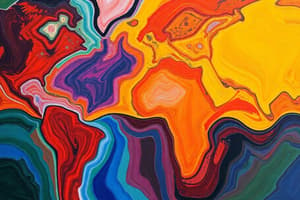Podcast
Questions and Answers
What is defined as a volcano with documented eruptions within the last 10,000 years?
What is defined as a volcano with documented eruptions within the last 10,000 years?
- Dormant Volcano
- Active Volcano (correct)
- Extinct Volcano
- Fumarole
What term describes the exact site where an earthquake begins, located below the epicenter?
What term describes the exact site where an earthquake begins, located below the epicenter?
- Seismic Zone
- Focus (correct)
- Epicenter
- Fault Line
Which type of seismic wave is the first to be recorded by a seismic station and can travel through solids, liquids, and gases?
Which type of seismic wave is the first to be recorded by a seismic station and can travel through solids, liquids, and gases?
- Surface Wave
- SS-Wave
- Secondary Wave
- Primary Wave (correct)
How thick can the Earth's crust range from, at its thinnest to its thickest?
How thick can the Earth's crust range from, at its thinnest to its thickest?
Which type of Earth's crust is thicker but less dense and not located under ocean areas?
Which type of Earth's crust is thicker but less dense and not located under ocean areas?
What is the average rate of movement for Earth's tectonic plates?
What is the average rate of movement for Earth's tectonic plates?
What type of wave is characterized as stronger and only travels through solids?
What type of wave is characterized as stronger and only travels through solids?
What do we call the graphical record of an earthquake?
What do we call the graphical record of an earthquake?
What is the process called when an oceanic plate slides under a continental plate?
What is the process called when an oceanic plate slides under a continental plate?
Which of the following best describes earthquakes?
Which of the following best describes earthquakes?
What type of seismic wave is the first to be recorded by a seismograph?
What type of seismic wave is the first to be recorded by a seismograph?
What geological feature is typically formed when two continental plates collide?
What geological feature is typically formed when two continental plates collide?
Which plate is the smallest tectonic plate mentioned?
Which plate is the smallest tectonic plate mentioned?
What phenomenon can occur due to strong earthquakes at the ocean floor?
What phenomenon can occur due to strong earthquakes at the ocean floor?
The Himalayas are primarily formed from the collision of which type of tectonic plates?
The Himalayas are primarily formed from the collision of which type of tectonic plates?
Which of the following correctly defines a seismograph?
Which of the following correctly defines a seismograph?
What is formed as crustal material fills the space created at divergent boundaries?
What is formed as crustal material fills the space created at divergent boundaries?
Which term describes the process where lithospheric plates slide past one another horizontally?
Which term describes the process where lithospheric plates slide past one another horizontally?
Which geological event is commonly associated with the movement of tectonic plates at convergent boundaries?
Which geological event is commonly associated with the movement of tectonic plates at convergent boundaries?
What is the primary cause of lithospheric plate movement?
What is the primary cause of lithospheric plate movement?
Which geological feature is most likely to form from divergent boundaries located under the sea?
Which geological feature is most likely to form from divergent boundaries located under the sea?
What describes the asthenosphere?
What describes the asthenosphere?
What phenomenon is a characteristic of transform boundaries, such as the San Andreas Fault?
What phenomenon is a characteristic of transform boundaries, such as the San Andreas Fault?
What is formed as a result of tectonic plate interactions at convergent boundaries?
What is formed as a result of tectonic plate interactions at convergent boundaries?
What occurs at divergent boundaries?
What occurs at divergent boundaries?
Which boundary type is associated with the subduction of one plate beneath another?
Which boundary type is associated with the subduction of one plate beneath another?
What geological feature is formed when two oceanic plates converge?
What geological feature is formed when two oceanic plates converge?
What happens when oceanic crust meets continental crust?
What happens when oceanic crust meets continental crust?
What is a common result of a continent-continent collision?
What is a common result of a continent-continent collision?
Which type of plate motion occurs at transform boundaries?
Which type of plate motion occurs at transform boundaries?
Which of the following reptiles was a coastal animal that lived during the early Permian period?
Which of the following reptiles was a coastal animal that lived during the early Permian period?
What can strong earthquakes generated at oceanic convergent boundaries potentially cause?
What can strong earthquakes generated at oceanic convergent boundaries potentially cause?
Where can fossils of the Lystrosaurus be found?
Where can fossils of the Lystrosaurus be found?
What is the primary effect of tectonic plates interacting at plate boundaries?
What is the primary effect of tectonic plates interacting at plate boundaries?
What significant role does the fossil Glossopteris play in understanding continental drift?
What significant role does the fossil Glossopteris play in understanding continental drift?
Which of these prehistoric animals was known to be a mammal-like reptile?
Which of these prehistoric animals was known to be a mammal-like reptile?
What does the presence of glacial deposits in South America and Africa suggest?
What does the presence of glacial deposits in South America and Africa suggest?
What were the limitations of Cynognathus and Lystrosaurus regarding ocean travel?
What were the limitations of Cynognathus and Lystrosaurus regarding ocean travel?
What is a key feature of the Mesosaurus's anatomy that aided in its movement?
What is a key feature of the Mesosaurus's anatomy that aided in its movement?
Which of the following correctly describes the ecological role of Glossopteris?
Which of the following correctly describes the ecological role of Glossopteris?
Flashcards are hidden until you start studying
Study Notes
Plate Tectonics Overview
- Active volcanoes have documented eruptions within the last 10,000 years.
- Earthquakes are vibrations caused by the rapid release of energy.
- The epicenter is located directly above an earthquake's focus, where the earthquake originates.
- Magma is molten rock found beneath the Earth’s surface.
- Mountain ranges comprise chains of mountains above the surrounding land.
Earth's Crust
- The crust is the Earth's outermost layer, consisting of solid rocks: sedimentary, metamorphic, and igneous.
- Average crust density is 2.8 g/cm³; thickness ranges from 5 km to 50 km.
- Continental crust is thicker but less dense, while oceanic crust is thinner but denser.
Tectonic Plates
- The lithosphere is divided into rigid plates that move slowly at a rate of about 1.5 cm annually.
- Major tectonic plates include the Pacific, North American, Eurasian, African, Antarctic, Indo-Australian, and South American plates.
- The Juan de Fuca Plate is the smallest, covering approximately 250,000 km², located west of Washington State and British Columbia.
Plate Boundaries and Movement
- Tectonic plates interact at plate boundaries, which can be divergent, convergent, or transform.
- Divergent boundaries occur where plates move apart, causing tension and sometimes forming rift valleys.
- Convergent boundaries involve plates colliding; subduction occurs when one plate slides under another, leading to volcanic activity and mountain formation.
- Transform boundaries feature plates sliding past each other, as exemplified by the San Andreas Fault.
Geologic Events at Boundaries
- Oceanic-continental convergence leads to the formation of mountain ranges (e.g., the Andes) and ocean trenches (e.g., the Philippine Trench).
- Oceanic-oceanic convergence creates volcanic island arcs and can trigger tsunamis.
- Continental-continental convergence results in large mountain ranges, such as the Himalayas, which includes Mount Everest, the tallest peak at 8,850 meters (29,035 feet).
Mechanisms of Plate Movement
- The asthenosphere is a soft layer where lithospheric plates float and move due to convection currents caused by heat transfer from the Earth’s core.
- Hot material rises, while cooler material sinks, facilitating the movement of lithospheric plates.
Fossil and Glacial Evidence
- Fossils of Cynognathus, Lystrosaurus, Mesosaurus, and Glossopteris indicate historical land connections among now-separated continents.
- Glacial deposits exist on various land masses such as South America, Africa, India, and Australia, showing past glacial activity indicative of continental links.
Key Geological Features
- Seismic waves include Primary (P-waves) and Secondary (S-waves), which are recorded by seismographs to create seismograms.
- Earthquake effects include the formation of trenches, mountains, and volcanic islands, emphasizing the dynamic nature of Earth's surface.
- Good luck on your exam!*
Studying That Suits You
Use AI to generate personalized quizzes and flashcards to suit your learning preferences.




